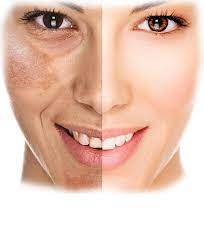
Melasma is a common skin condition that causes dark patches and uneven pigmentation, usually on the face. It often results from hormonal changes, sun exposure, and genetics, making it a challenging condition to treat. Many people in Dubai seek pigmentation treatments to reduce the appearance of melasma and restore a more even skin tone.
With advanced pigmentation treatment (علاج التصبغ) options available, individuals struggling with melasma can achieve significant improvement. This guide explores how these treatments work, their effectiveness, and what to expect when undergoing pigmentation correction.
What Causes Melasma?
Sun Exposure:
The strong sunlight in Dubai is one of the leading triggers for melasma. UV rays stimulate melanin production, causing dark spots to become more prominent.
Hormonal Changes:
Melasma is often linked to hormonal fluctuations, particularly in pregnant women, those taking birth control pills, or undergoing hormone therapy. This type is sometimes referred to as the “mask of pregnancy.”
Genetics:
Individuals with a family history of melasma are more likely to develop the condition.
Skin Irritation:
Using harsh skincare products, aggressive exfoliation, or chemical peels can sometimes worsen pigmentation issues, making melasma harder to manage.
Types of Pigmentation Treatments for Melasma:
Laser Treatments:
Laser therapy is a popular pigmentation treatment that targets melanin deposits in the skin. It breaks down excess pigment, allowing the body to naturally remove dark patches over time.
How It Works?
- A specialized laser device delivers light energy to the affected areas.
- The melanin absorbs the energy, breaking apart the pigmentation.
- Over the next few weeks, the skin gradually clears up as the body eliminates the excess pigment.
Effectiveness for Melasma:
- Mild to moderate cases often show good results.
- Multiple sessions may be required for deeper pigmentation.
- Results vary, and proper sun protection is essential to prevent recurrence.
Chemical Peels:
Chemical peels exfoliate the skin, removing damaged outer layers and promoting fresh, even-toned skin.
How It Works?
- A chemical solution is applied to the skin.
- The old skin peels off, revealing brighter, less pigmented skin underneath.
- Over time, this helps reduce melasma patches and even out skin tone.
Effectiveness for Melasma:
- Works well for superficial pigmentation.
- Not always effective for deep-seated melasma.
- Requires regular sessions and strict sun protection.
Microneedling with Serums:
Microneedling creates tiny micro-injuries in the skin, allowing brightening serums or growth factors to penetrate deeper.
How It Works?
- A device with fine needles creates controlled micro-injuries.
- Special serums, such as vitamin C or tranexamic acid, are applied.
- This stimulates collagen production and promotes skin renewal.
Effectiveness for Melasma:
- Helps improve skin texture and mild pigmentation.
- Works well when combined with other pigmentation treatments.
- Multiple sessions are needed for best results.
Topical Treatments:
Prescription and medical-grade topical creams are often used to manage melasma.
Common Ingredients in Pigmentation Treatments:
- Hydroquinone – A skin-lightening agent that reduces melanin production.
- Retinoids – Promote cell turnover and exfoliate pigmented skin.
- Vitamin C – Brightens the skin and helps fade dark patches.
- Azelaic Acid – Helps lighten hyperpigmentation safely.
- Tranexamic Acid – Reduces pigmentation caused by inflammation or hormones.
Effectiveness for Melasma:
- Works well for mild melasma.
- Requires consistent use for noticeable results.
- Best used in combination with other treatments.
How to Choose the Right Pigmentation Treatment in Dubai?
When selecting a pigmentation treatment, consider the following factors:
Severity of Melasma:
- Mild cases may respond well to topical treatments.
- Moderate cases may require chemical peels or microneedling.
- Severe melasma often needs laser therapy or a combination of treatments.
Skin Type and Sensitivity:
- Some treatments may irritate sensitive skin or cause temporary redness.
- A professional skin assessment can determine the most suitable option.
Aftercare and Maintenance:
- Sun protection is critical to prevent melasma from returning.
- Follow a customized skincare routine to maintain results.
- Avoid harsh products or excessive exfoliation.
Preventing Melasma from Worsening:
Even after undergoing pigmentation treatment, it is essential to take precautions to prevent melasma from reappearing.
Daily Sunscreen Use:
- Use broad-spectrum SPF 50+ sunscreen.
- Reapply every two hours, especially when outdoors.
- Wear hats and sunglasses for extra protection.
Avoid Hormonal Triggers:
- If possible, consider alternative birth control options.
- Discuss hormonal treatments with a professional if melasma worsens.
Use Gentle Skincare Products:
- Avoid harsh exfoliants, strong acids, and alcohol-based toners.
- Stick to hydrating and soothing ingredients.
Conclusion:
pigmentation treatment (علاج التصبغ) can effectively reduce melasma and improve skin tone. The best approach depends on the severity of the condition, skin type, and lifestyle habits.
For mild cases, topical treatments and chemical peels may provide significant improvement. For stubborn or deep-seated melasma, laser treatments and microneedling offer more advanced solutions. However, sun protection and proper skincare are essential to maintain results and prevent melasma from returning.







